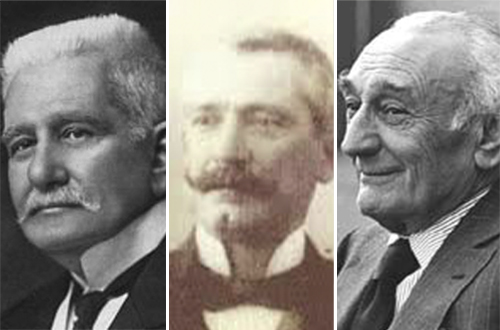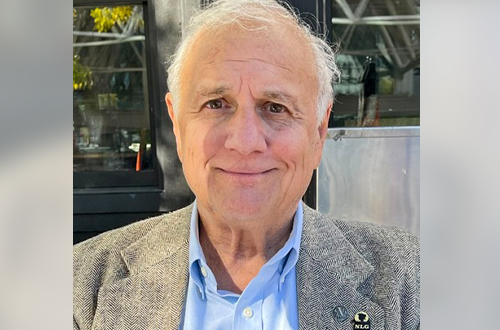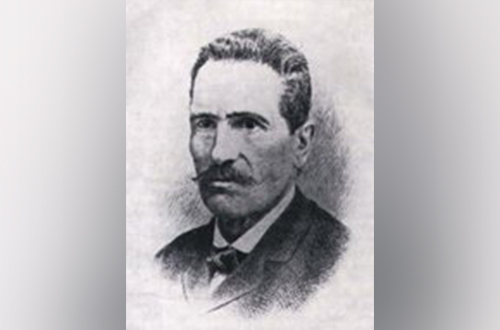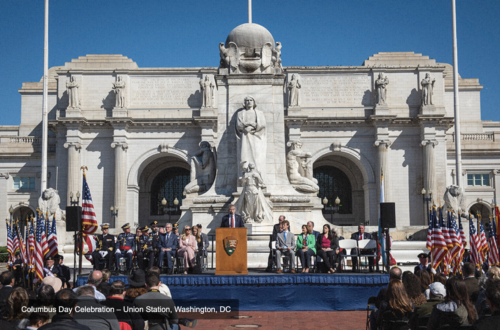-
Three Entrepreneurs from Abruzzo
By Joseph “Sonny” Scafetta, Jr.
The Notiziario has in recent years presented profiles of individuals from Abruzzo or with roots in the province who have made their marks in the world of the arts. Abruzzo has also produced some talented and successful businessmen. Here is a look at three of them.
Raffaele Cappelli (1848-1921)
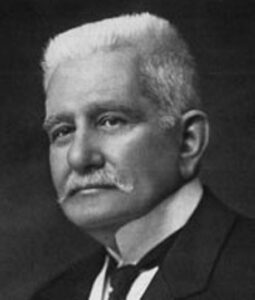
Raffaele Cappelli
Credit: WikipediaRaffaele Cappelli was born in the community of San Demetrio ne’ Vestini (population 2,913 in the first Italian Census of 1861), in the province of L’Aquila in the region of Abruzzo, on March 23, 1848. His father was Salvatore Cappelli and his mother was Maria Maddalena Borgia. He had two siblings.
After he earned a degree in jurisprudence from the University of Naples in 1870, he commenced a diplomatic career for the Kingdom of Italy. He was first attached to the embassy in London. He returned to Naples in 1874 to marry his university sweetheart, Maria Pasqua. They had one son whom Raffaele named after himself. His next assignment was to the embassy in Vienna. He was next transferred by the kingdom to Berlin.
Realizing a lack of advancement in the diplomatic service, he resigned to return to his home province and run for the position of deputy in the lower house of the Italian Parliament as a member of the Historic Right Party. He was elected to the Chamber of Deputies on his first try in 1878. In 1885, he was chosen by the prime minister to be the general secretary of the Ministry of Foreign Affairs because of his prior diplomatic service. He served two years in this position.
Returning to the Chamber of Deputies, he developed a particular interest in agrarian reform because starvation was still a problem in different parts of Italy at that time. As a result, he was elected president of the Society of Italian Agriculturists in 1896. On April 6, 1897, he was elected vice president of the Chamber of Deputies.
In 1906, he decided to use one of his small farms as an experimental station. He hired Nazareno Strampelli, a competent agronomist and geneticist, to cross breed different wheat species to create a type that would be drought resistant. Eventually, his wheat experiments, conducted with Strampelli, resulted in the creation of a new drought-resistant wheat strain which was called Cappelli. Prior to its development, Italy was a net importer of wheat from Russia and the United States. After the seeds of the new strain were distributed nationwide, Italy became self-sufficient and no longer imported wheat from other countries. For his work, King Victor Emmanuel III made Cappelli a Marchese and a Cavaliere of the Grand Cross in the Order of the Saints Maurizio and Lazzaro on March 23, 1911, his 63rd birthday.
Back in the Chamber of Deputies, when the prime minister asked for a declaration of war against the Central Powers in May, 1915, Cappelli campaigned against the declaration, but it passed over his objections and Italy entered World War I on the side of the Allies. Nevertheless, Cappelli continued as vice president. After the war was over, he was elected Senator for Life on October 6, 1919. He served in the Senate, which is the upper house of the Italian Parliament, until his sudden death from a heart attack in Rome on June 1, 1921. He was 73 years old.
Sources (all accessed February 28, 2021):
- https://it.wikipedia.org/wiki/Raffaele_Cappelli
- https://www.myheritage.com/names/raffaele_cappelli
- https://it.wikipedia.org/wiki/San_Demetrio_ne’_Vestini
- https://www.lamiola.com/wheat-senatore-capelli–history-important-grain
Beniamino Laccetti
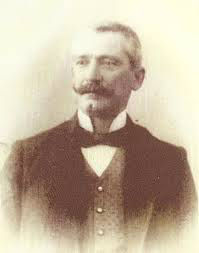
Beniamino Laccetti
Credit: Vastesi in the WorldBeniamino Laccetti was born on January 25, 1855, in the city of Vasto in the province of Chieti in the region of Abruzzo. Although he was a good student in school, his father took him out when Ben reached 14 and put the teen to work in the family’s mercantile trading business. Nevertheless, during his free time in the evenings, Ben taught himself by reading library books, particularly on geography and agriculture.
When he turned 21, Ben was sent by his father to Naples because it had a large harbor from which the family could continue to carry out its commercial activities. From the port of Naples, Ben opened trade with eastern European countries, particularly Romania, and then Africa. As a result, in 1898, he became a member of the African Society which supported the colonial activities of the Royal Italian Government in northern and eastern Africa.
However, the dream that absorbed Ben all his life was the building of a port at Punta Penna (Feather Point) which had a deep harbor located at the northern end of Vasto along the Adriatic seacoast. Ben imagined that Vasto could then take part in direct international trade. After much lobbying in Rome by Vastesi businessmen, King Victor Emmanuel III issued a royal decree in 1907 declaring Punta Penna to be the future site of a harbor with dual functions as a military and commercial port. After the Vasto City Council approved engineering plans for building the port, Ben went to Rome and presented the Italian Government with a plan. He proposed to bear the entire cost of the construction of the port if he would be granted a 30-year concession as a free trader so that he could recover his building costs by not paying any export and import duties. The Italian Government turned down his proposed private-public plan.
Dejected, Ben returned in 1920 to Naples where he became a member of the governing council of the African Society. He also became the General Secretary of the Circolo del Commercio (Circle of Commerce) in Naples. He then began publishing various studies and proposals, reported in over 20 publications, all international in character, for improving trade for Italy. In 1936 at the age of 81, Ben printed his last work: “Le Nostre Colonie: Cenni Geografici Generali” (Our Colonies: General Geographical Signs) with the explanatory subtitle “Studio Pratico per I Lavoratori” (Practical Study for the Workers). This guide summarized all his experience and knowledge gleaned from years of trading in various geographical areas. It was intended to pass advice on to young workers who were just beginning their colonial businesses.
Taking his own advice, Ben decided in 1939 to extend his business to Eritrea, which at that time was a province in northern Ethiopia, in eastern Africa. After the British Army drove the Italian Army out of Ethiopia, he relocated to the city of Tripolitania (now Tripoli) in Libya. When the American and British Armies drove the German and Italian Armies out of Libya, Ben returned to Naples. In 1946, the new Italian Republic adopted a plan to build a port at the naturally deep harbor of Punta Penna. In May 1948, Ben returned to his hometown of Vasto to witness the laying of the first stone of the port at Punta Penna. Finally, as a happy man, he returned to Naples where the life-long bachelor died after a year on May 16, 1949, at the age of 94.
Source accessed September 25, 2020:
Henry Salvatori
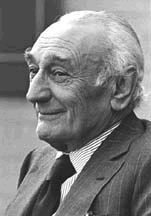
Henry Salvatori
Credit: USC NewsErcole Salvatori was born in the community of Tocco da Casauria (population 2,662 in the 2017 Census) in the province of Pescara in the region of Abruzzo, on March 28, 1901. On April 17, 1908, the seven-year-old Ercole arrived at Ellis Island with his mother, Francesca di Giulio, and his two sisters. They soon joined Ercole’s father who had already settled on a farm in southern New Jersey. When the family members became U.S. citizens, Ercole changed his name to Henry.
Afterwards, the family moved to the Little Italy section of south Philadelphia where his father started a successful wholesale grocery business. Henry graduated from the local public high school in 1919. He earned a Bachelor of Science degree in electrical engineering from the University of Pennsylvania in Philadelphia in 1923 and a Master of Science degree in physics from Columbia University in New York City in 1926.
He then went to work as a geophysicist for Geophysical Service, Inc. In 1933 during the depth of the Great Depression, he left to establish the Western Geophysical Company of America in California. The company used reflection seismology to explore for oil and prospered. In 1938 at the age of 37, Henry married a 25-year-old actress named Grace Ford. They had a son, Henry Ford Salvatori (June 29, 1940 – July 23, 2016), and a daughter, Laurie Salvatori Champion, who was born on May 4, 1948. In 1961, the 60-year-old Salvatori merged Western Geophysical into Litton Industries and became chairman and chief executive officer of the joint company.
He then began a second career as a political activist. He started in 1962 by working in Richard Nixon’s unsuccessful campaign for governor of California. Next, in 1964, he chaired Barry Goldwater’s unsuccessful presidential campaign in California. In 1966, Salvatori served as state finance chairman for Ronald Reagan’s successful campaign for governor.
After retiring from Litton and tiring of state politics in 1969, Salvatori turned his attention to a third career as a philanthropist. That year he founded the Henry Salvatori Center for the Study of Individual Freedom in the Modern World at Claremont McKenna College, a private liberal arts school in Claremont, California. Over the course of the next two decades, he made large donations to the following: the Dorothy Chandler Pavilion which is an opera house in Los Angeles; the University of Southern California where he served as a life trustee; the University of Pennsylvania; Columbia University; Stanford University; Pepperdine University; Boston University; Saint Thomas Aquinas College in Sparkill, New York; and Hillsdale College in Hillsdale, Michigan.
After his wife died on May 5, 1990, he established the Henry Salvatori Foundation which endowed the Henry Salvatori Professorship in American Values & Traditions at Chapman University and the Henry Salvatori Professorship in Law & Community Service at the Chapman University School of Law in Orange, California. In 1991, he was honored by the Young America’s Foundation which created the annual Henry Salvatori Lecture Series. As a long-time member of the Order of the Sons (now & Daughters) of Italy in America, he donated in 1995 a corpus large enough to earn at least $5,000 in interest to fund the Henry Salvatori Scholarship which is given yearly to a worthy Italian-American student. The prize is now given in the name of his late son, Henry F. In 1996, the Heritage Foundation established the Salvatori Prize for American Citizenship which is awarded annually. He died in the Saint John’s Medical Center in Santa Monica, California, on July 6, 1997, at the age of 96.
Sources, all accessed June 22, 2021:
- https://en.wikipedia.org/wiki/Henry_Salvatori
- https://news.usc.edu/11494/Trustee-Henry-Salvatori-Dies-at-96/
- https://en.wikipedia.org/wiki/Tocco_da_Casauria
- https://en.wikipedia.org/wiki/Wesrern_Geophysical
- https://www.imdb.com/name/nm0285663/
- https://www.legacy.com/obituaries/latimes/obituary.aspx?pid=180
- https://www.mylife.com/laurie-champion
- https://en.wikipedia.org/wiki/Claremont_McKenna_College
- https://en.wikipedia.org/wiki/Dorothy_Chandler_Pavilion
- https://en.wikipedia.org/wiki/St._Thomas_Aquinas_College
- https://en.wikipedia.org/wiki/Hillsdale_College
- https://en.wikipedia.org/wiki/Chapman_University
September/October 2023
-
Expert Details Roman Coin Transition from Metal Lumps to Imperial Gold Coins
Topic of Virtual Talk
By Nancy DeSanti, 1st Vice President-Programs
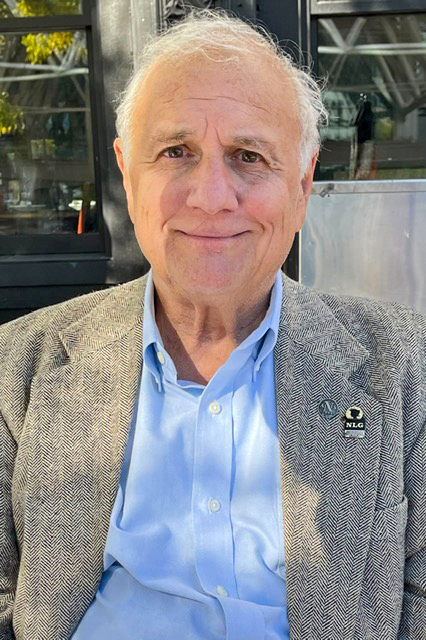
Michael Markowitz AMHS members were treated to a very informative and entertaining virtual talk, “Show Me the Money!” on July 30, 2023, by Michael Markowitz, an expert on Roman coinage. who told us about its evolution from lumps of metal in 300 B.C. to imperial gold coins in 476 A.D.
Mike was born in New York City. His mother’s side of the family is Italian, while his father’s ancestors emigrated from Romania. Mike attended the University of Rochester, then the University of California, Irvine. He worked for many years in the aerospace industry in southern California before moving in 1991 to northern Virginia where he is a senior research specialist for the Center for Naval Analyses.
He is a contributing writer on ancient and medieval coins for CoinWeek.com. He is a member of the American Numismatic Society and the Ancient Numismatic Society of Washington, D.C. He also serves on the board of directors of the Fairfax Coin Club. Mike said that one of his most memorable experiences was spending an afternoon inside the coin vault of the archaeological museum in Siracusa, Sicily.
As Mike told the audience, we collect coins to hold history in our hands. He explained that coins showed symbols the government wanted to communicate to people who were largely illiterate. He noted that Petrarch was one of the first Roman coin collectors. Amazingly, he said there are at least 21,669 different types of Roman coins, according to one authoritative source. As many as 40,000 coins have been found buried in clay pots in fields in rural areas — not surprising since there were no banks then.
He said that for less than $25, you can buy a Roman coin of Constantine the Great with a woman in a winged helmet, and he added that there were many images of women as the personification of virtue. Zenobia, Queen of Palmyra, was one of the women who had a coin made in her image. He noted that the Constantine the Great coin showed a watchtower on the reverse side because, due to the barbarian invasions, there was a need for watchtowers.
A fantastically detailed coin of the Colosseum is one of the rarest coins, he said, and one of them sold in 2011 for over $400,000.
The coin that got Caesar killed, he told us, came about when Julius Caesar put his portrait on a coin as “dictator in perpetuity” which rubbed some senators the wrong way and led to the conspiracy that resulted in his assassination. Interestingly, he said that the word “Caesar” gave rise to the words, “tsar” and “kaiser.”
He noted that the penalties for counterfeiting were barbaric — hands and heads were chopped off — since that was considered an offense against the emperor. But he joked that counterfeiting was invented about a week after coins were invented, and surprisingly, these counterfeits are still collectibles. He warned that a high percentage of Roman coins on eBay are fakes coming from Eastern Europe and China.
There are billions of coins still in the ground in the territories of the former Roman Empire, he said. He added that laws vary as to who gets ownership, but in many countries metal detectors are illegal, so in some countries it is a shady “underground” business.
Mike said the most beautiful coins of the ancient world were from the 4th and 5th centuries B.C., made by talented Greek engravers and found in Siracusa, Sicily.
He pointed out that Olympic medals represent the materials that coins were made of gold, silver, and bronze which was the most plentiful of the three, also used for making armor and weapons. He said coin making was a tough job, and coin makers working in the mint wore black hats so their hair would not catch on fire from the flying sparks.
Mike said one of the best places to see Roman coins is the Museo Nazionale Romano near the Termini train station in Rome. King Vittorio Emanuele III was an expert in Roman coins, and he left his collection to this museum. Mike said he recently checked the website of the Museo Nazionale, and it is unfortunately closed until further notice.
Other important collections of Roman coins are found in the Hermitage in St. Petersburg, Russia, and in London, Paris, and Berlin. He said that the Smithsonian Institution does not exhibit Roman coins due to the difficulty in curating them and because of the security risks.
September/October 2023
-
Digging in the Dirt in Abruzzo and Molise: Noted Archeologist Antonio De Nino
By Joseph “Sonny” Scafetta, Jr.
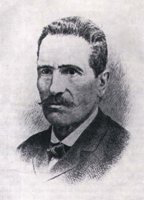
Antonio De Nino
Credit: WikipediaAntonio De Nino was born in the community of Pratola Peligna (population 7,249 in the 2020 Census) in the province of L’Aquila in the region Abruzzo on June 15, 1833. Nothing has been published about his parents, his education, and his immediate family, if any. There was nothing in his background to suggest that he would one day return to his home region as a successful archaeologist.
He first appeared in public records in 1861 when, at the age of 28, he became an elementary school teacher in San Demetrio ne’ Vestini in the province of L’Aquila. After a year, he transferred to teach high school in the town of Leonessa in the province of Rieti in the region of Lazio. In 1872, he was appointed a professor at the “Publio Ovidio Nasone” Technical School, a classics-based secondary school in the city of Sulmona in the province of L’Aquila.
While living in Sulmona, he became interested in archeology and began to study popular local traditions. His first publication Armi Preistoriche (Prehistoric Weapons) appeared in the Gazette of Sulmona in 1874. The Ministry of Public Instruction in Rome appointed him Inspector of Monuments in 1877 and directed him to make excavations systematically in Abruzzo. During that same year, the Lincei Academy began to publish his annual Notizie Degli Scavi (News About Excavations). Later, his reports were printed in the Bulletin of the Institute of Archeology of Italy.
His first major excavation was in the plain of Pentima where the city of Corfinio was built over the ancient town of Corfinium that had been proclaimed the rebel capital of Italy by the Paeligni, an Italic tribe, in 89 B.C. While working there, he discovered the inscription of Herentas, the most important epigraphic text in the language of the Paeligni. He later opened another important excavation campaign at Campo Consolino near the town of Alfedena. The site was a fortified citadel with a cemetery for a city of the Pentri, one of the chief Samnite tribes which disappeared from the historic record after 216 B.C. In the cemetery, De Nino’s team opened 42 tombs which contained the remains of individuals dressed in tribal wardrobes. Over the course of 30 years, he opened 107 excavation campaigns throughout Abruzzo, Molise and Lazio.
Meanwhile, De Nino wrote five tomes entitled Usi e Costumi Abruzzesi (Abruzzesi Usages and Costumes) which appeared in 1879, 1881, 1883, 1887 and 1891. They are all collections of descriptions of local customs and dresses in different parts of Abruzzo. The books are still of fundamental importance for understanding the origins of most popular practices today.
De Nino died in Sulmona on March 1, 1907, at the age of 73. After his death, Sulmona dedicated a street in its historic center in his honor. Also, four archeological museums in Abruzzo are named for him. They are located in his birthplace of Pratola Peligna, in the town of Alfedena, in the city of Corfinio, and in the Convent of the Maddalena at Castel di Sangro.
Sources:
September/October 2023
-
Aielli

By Nancy DeSanti
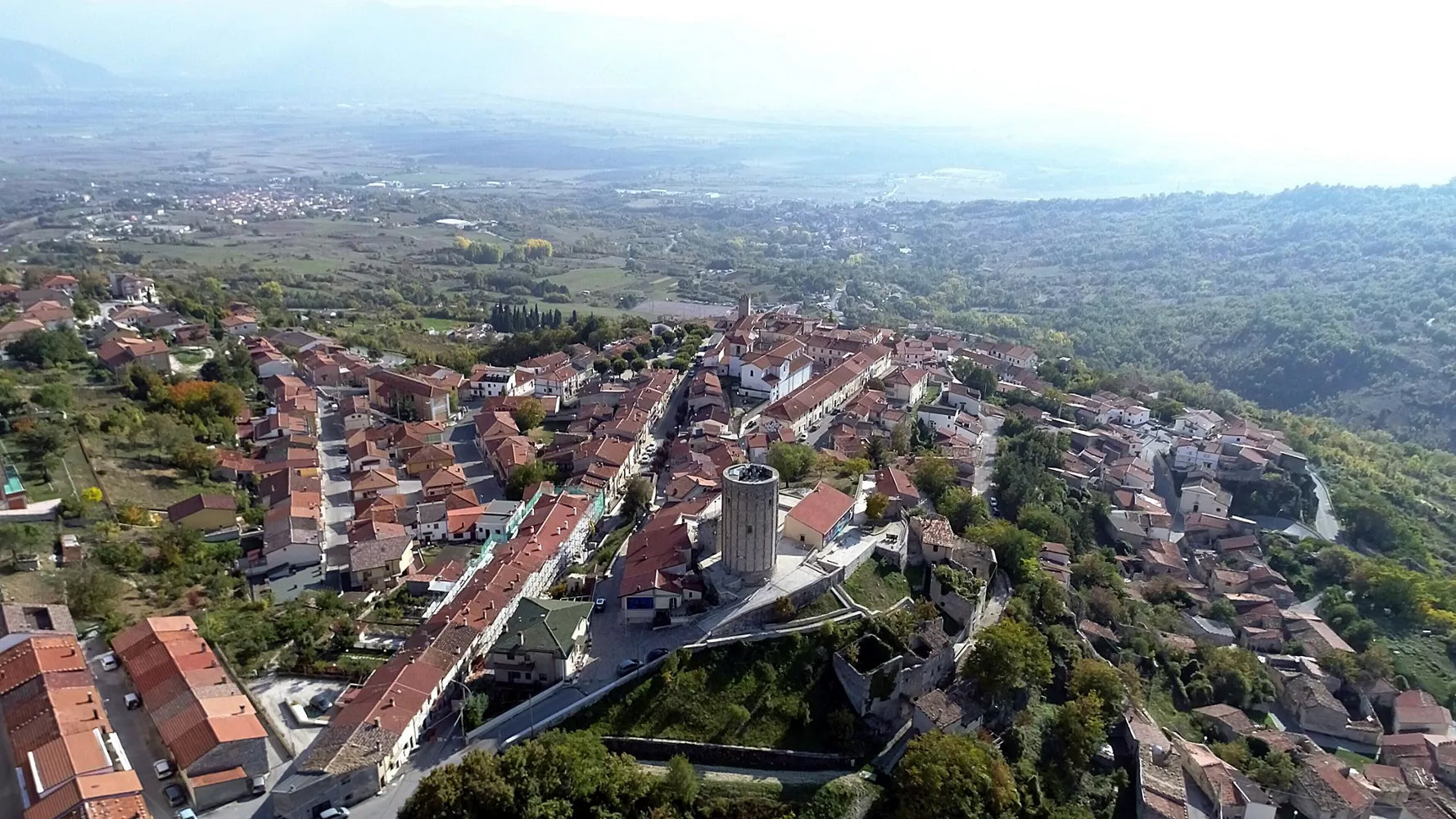
Credit: italia.it Province of L’Aquila, Region of Abruzzo
The beautiful small town of Aielli is located in the province of L’Aquila. It has approximately 1,021 inhabitants, known as Aielesi. Famous for its astronomy and planetary observatory, it is located in the plain of the former Lake Fucino, in the Marsica.
Located on a hill overlooking the whole Fucino basin, Aielli has such fine medieval sights as the cylindrical 14th century tower, once belonging to a larger fortified structure built by Ruggero, Count of Celano, and remarkable churches. Much later, in 1915, an earthquake destroyed a large part of the small town.
The town of Aielli, whose territory is part of the Velino-Sirente Regional Park, is perched on a rocky limestone spur, surrounded by two streams. This position has for centuries made it the ideal place to defend and observe the territory.
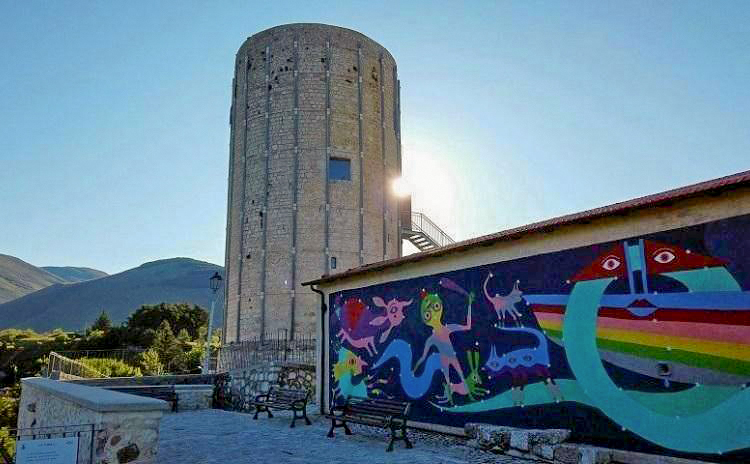
The 14th century cylindrical tower in Aielli.
Credit: Italy by EventsAielli is also rich in historical and artistic elements of great value, among which the imposing 14th century medieval tower known as the Torre delle Stelle (Tower of the Stars) stands out. Today it is an important astronomical observatory open to the public, which also houses the Museo del Cielo (Museum of the Sky) and a scientific library. The observatory is open year-round.
The museum is located in a beautiful square with a particular sundial in the center. More recently, the Museum of the Sky was dedicated to the moon and to outer space. It was inaugurated in 2019 on the occasion of the 50th anniversary of the first moon landing by Neil Armstrong and Buzz Aldrin on July 20, 1969.
Telescopes and other instruments are displayed to show the constellations and the stars. Inside the museum, there is also a specialized scientific library, various optical instruments, a single-channel digital planetarium, some computerized stations for animations and simulations, several photographs of the moon landing, and some sundials. Also on display is the reproduction of the Apollo lunar module with material on the lunar missions and a copy of the spacesuit worn by Armstrong.
In the Tower of the Stars, visitors can take part in various activities, astronomical observations, educational workshops, guided tours and shows, both during the day and at night. There are also workshops for children.
What to See
- The Cylindrical Tower
- The Church of San Rocco
- The beautiful Church of San Adolfo at Aielli Stazione, built in the 1930s with artwork by the sculptor, Arturo Dazzi.
- The remains of a hermitage below Mount Etra.
Important Dates
- August – Festival of the Amaretti (typical cookies made from almonds)
Italiano

Tradotto da Romeo Sabatini
Provincia di dell’Aquila, Regione Abruzzo
La bellissima cittadina di Aielli si trova in provincia dell’Aquila. Ha circa 1.021 abitanti, conosciuti come Aielesi. Famoso per l’astronomia e l’osservatorio planetario, si trova nella piana dell’ex Lago Fucino, nella Marsica.
Su un colle che domina l’intero bacino del Fucino, Aielli conserva ancora pregevoli testimonianze medievali come la torre cilindrica trecentesca, un tempo parte di una più ampia struttura fortificata voluta da Ruggero, conte di Celano, e notevoli chiese. Molto tempo dopo, nel 1915, un terremoto distrusse gran parte della cittadina.
Il comune di Aielli, il cui territorio fa parte del Parco Regionale del Velino-Sirente, è arroccato su uno sperone roccioso calcareo, circondato da due torrenti. Questa posizione ne ha fatto per secoli il luogo ideale per difendere e osservare il territorio.
Aielli è inoltre ricca di elementi storico-artistici di grande pregio, tra i quali spicca l’imponente torre medievale del XIV secolo detta Torre delle Stelle. Oggi è un importante osservatorio astronomico aperto al pubblico, che ospita anche il Museo del Cielo e una biblioteca scientifica. L’osservatorio è aperto tutto l’anno. Il museo si trova in una bellissima piazza con al centro una particolare meridiana.
Più recentemente, il Museo del Cielo è stato dedicato alla luna e allo spazio ed è stato inaugurato nel 2019 in occasione del 50° anniversario del primo allunaggio di Neil Armstrong e Buzz Aldrin il 20 luglio 1969.
Vengono visualizzati telescopi e altri strumenti per mostrare le costellazioni e le stelle. All’interno del museo si trovano anche una biblioteca scientifica specializzata, vari strumenti ottici, un planetario digitale monocanale, alcune postazioni computerizzate per animazioni e simulazioni, diverse fotografie dell’allunaggio e alcune meridiane. In mostra anche la riproduzione del modulo lunare dell’Apollo con materiale sulle missioni lunari e una copia della tuta spaziale indossata da Armstrong.
Nella Torre delle Stelle i visitatori possono prendere parte a diverse attività, osservazioni astronomiche, laboratori didattici, visite guidate e spettacoli, sia diurni che notturni. Ci sono anche laboratori per bambini.
Le attrazioni del luogo:
- La Torre Cilindrica
- Chiesa di San Rocco
- La bella Chiesa di San Adolfo ad Aielli Stazione, costruita negli anni ’30 con l’opera dello scultore, Arturo Dazzi.
- I resti di un eremo sotto il Monte Etra.
Date da ricordare:
- Agosto – Sagra of Amaretti (tipici biscotti delle mandorle)
September/October 2023
-
Civitacampomarano

By Nancy DeSanti
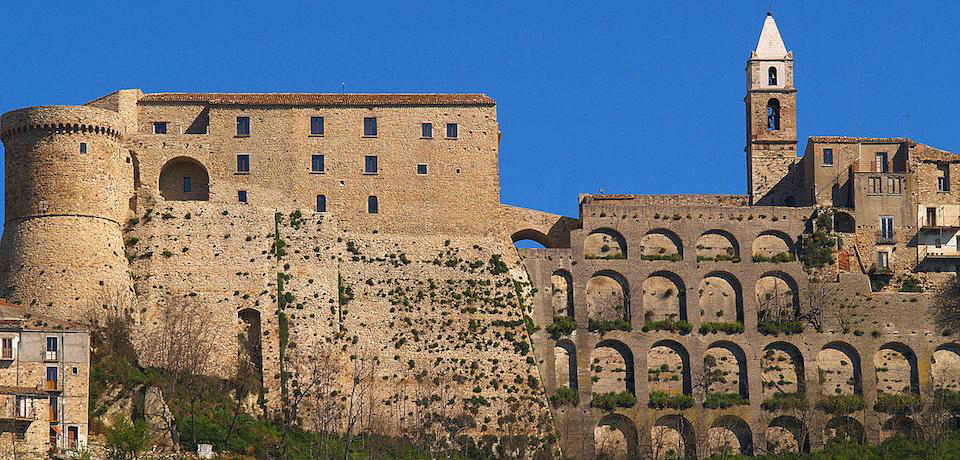
The Angevine Castle
Credit: Italy Magazine
Province of Campobasso, Region of Molise
The small town of Civitacampomarano is located in the province of Campobasso, about 25 kilometers north of the city of Campobasso, on the left side of the Biferno river. It has approximately 520 inhabitants, known as Civitesi. It is known as the Street Art Capital of Molise.
An ancient fortress existed in the area prior to the year 1000 AD, when the Anjou later built their castle. The first recorded feudal lord was Paolo Marchisio. Then in the 13th century, Charles of Anjou gave the fiefdom to the princes of Taranto. They were succeeded in 1328 by Nicola from Boiano, and still later by the di Sangro and the Mirelli families.
In recent years, the town had been at risk of becoming a ghost town since most of its inhabitants left in search of a better future elsewhere. Then, in 2014 Ylenia Carelli, the president of the local cultural organization ProLoco “Vincenzo Cuoco,” got in touch with Roman street artist Alice Pasquini after watching her interview on TV and invited her to help revitalize the village through street art. The artist immediately accepted and made a series of murals inspired by some old photographs.
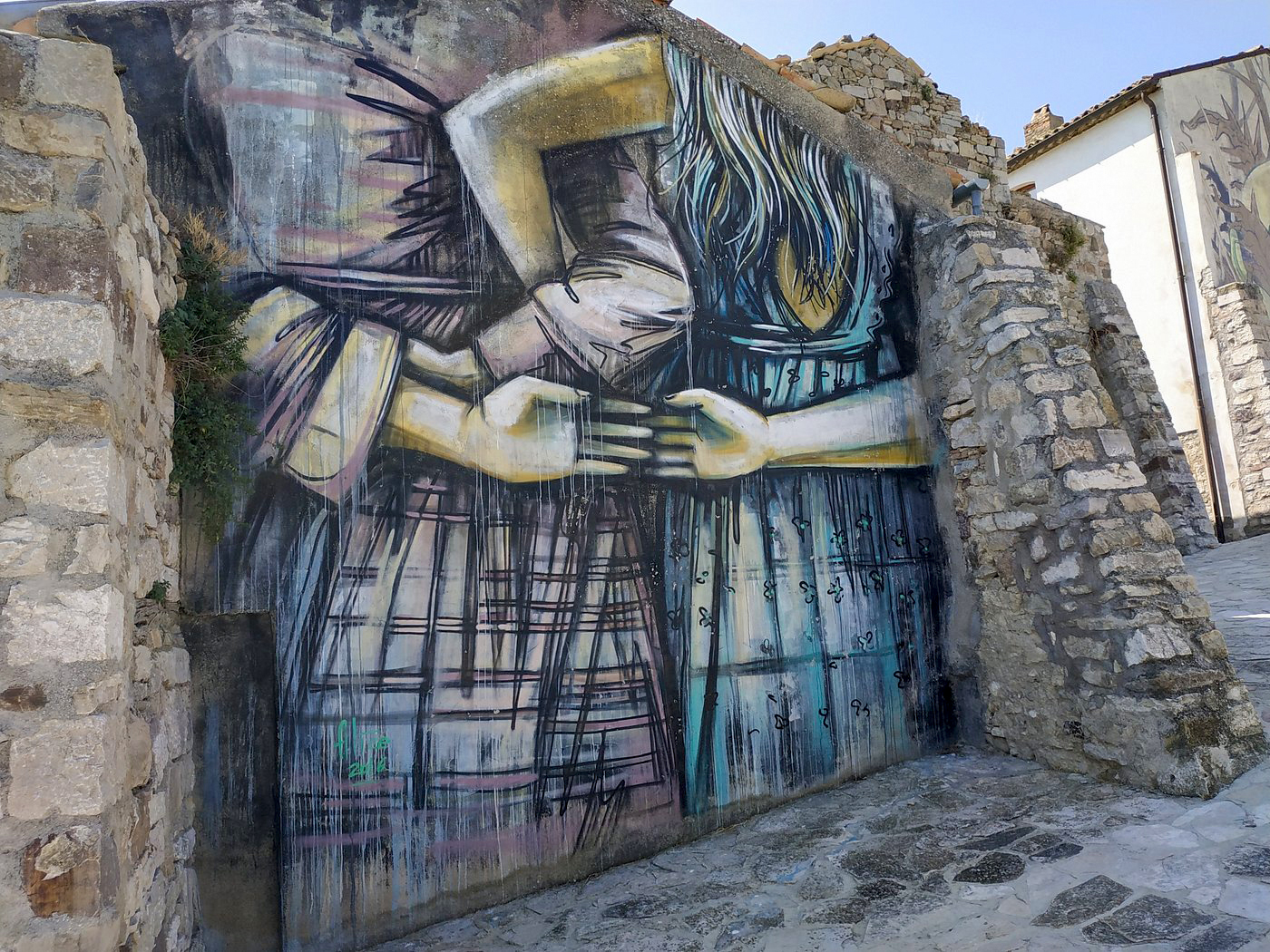
CVTà Street Fest in Civitacampomarano
Credit: Italy MagazineThis artistic project begun in 2016 managed to bring new life to the village and soon evolved into a festival, CVTà Street Fest. “CVTà” is the way residents used to call their town in dialect. Now this event sees the participation of street artists from all over the world. They come to Civitacampomarano to leave their visual mark on the walls that residents eagerly make available. The murals are perfectly integrated into the village, making it a fantastic open-air gallery.
Visually impressive, brightly colored murals are painted onto the walls of old buildings as a way of rediscovering the town’s historical center, fascinating everyone who pauses to admire them. The festival is one of the challenges won by this visionary village: to capture beauty through art and its ability to narrate ever-popular stories.
Street art is not the only attraction in Civitacampomarano. For example, there is a splendid Angevine castle dating back to the 13th century. Its imposing structure dominates the entire town.
The town is known for cielli, a cookie filled with a mixture of fruits or grape must. It is the birthplace of soldier and patriot, Gabriele Pepe, and of politician, Risorgimento patriot, writer, and historian, Vincenzo Cuoco.
Among the other sights worth visiting are the Church of Santa Maria Maggiore, the Church of Santa Maria delle Grazie with a late Gothic portal, and the Church of San Giorgio Martire.
What to See
- Angevine Castle from the 13th century, with two typical round towers
- Church of Santa Maria Maggiore (c. 11th century)
- Church of Santa Maria delle Grazie, with a late Gothic portal.
- Church of San Giorgio Martire
- Home of Risorgimento patriot, Vincenzo Cuoco
- Vallemonterosso Park
Italiano

Tradotto da Romeo Sabatini
Provincia di Campobasso, Regione Molise
Il piccolo comune di Civitacampomarano si trova in provincia di Campobasso, a circa 25 chilometri a nord di Campobasso sulla sponda sinistra del fiume Biferno. Conta circa 520 abitanti, detti Civitesi. È conosciuta come la Capitale della Street Art del Molise.
Un’antica fortezza esisteva nella zona prima dell’anno 1000 dC, quando in seguito gli Angioini costruirono il loro castello. Il primo feudatario di cui si abbia notizia fu Paolo Marchisio. Poi nel XIII secolo Carlo d’Angiò concesse il feudo ai principi di Taranto. Quali successero nel 1328 per Nicola da Boiano, e ancora successivamente i di Sangro ei Mirelli famiglie.
Negli ultimi anni, la cittadina ha rischiato di diventare una città fantasma poiché la maggior parte dei suoi abitanti è partita in cerca di un futuro migliore altrove. Poi, nel 2014 Ylenia Carelli, presidente della locale organizzazione culturale ProLoco “Vincenzo Cuoco”. Ha contattato la street artist romana Alice Pasquini dopo aver visto la sua intervista in tv e l’ha invitata a rivitalizzare il paese attraverso la street art. L’artista accettò subito e fece una serie di murales ispirati ad alcune vecchie fotografie.
Questo progetto artistico iniziato nel 2016 è riuscito a portare nuova vita al paese e ben presto si è evoluto in un festival, il CVTà Street Fest. “CVTà” è il modo dialettale con cui i residenti chiamavano la loro città. Ora questo evento vede la partecipazione di artisti di strada provenienti da tutto il mondo che vengono a Civitacampomarano per lasciare la loro impronta visiva sui muri che i residenti mettono a disposizione con entusiasmo. I murales sono perfettamente integrati nel villaggio, rendendolo una fantastica galleria a cielo aperto.
Di grande impatto visivo, murales dai colori vivaci sono dipinti sui muri di vecchi edifici per riscoprire il centro storico della città, affascinando chiunque si soffermi ad ammirarli. Il festival è una delle sfide vinte da questo villaggio visionario: catturare la bellezza attraverso l’arte e la sua capacità di raccontare storie sempre popolari.
La street art non è l’unica attrazione di Civitacampomarano. Ad esempio, vi è uno splendido castello angioino risalente al XIII secolo. La imponente struttura domina l’intero paese.
La città è nota per i cielli, un biscotto ripieno di una miscela di frutta o mosto d’uva. Ha dato i natali al soldato e patriota, Gabriele Pepe, e al politico, patriota risorgimentale, scrittore, e storico, Vincenzo Cuoco.
Tra i oltri monumenti da visitare vi sono la Chiesa di Santa Maria Maggiore, la Chiesa di Santa Maria delle Grazie, con portale tardogotico, e la Chiesa di San Giorgio Martire.
Le attrazioni del luogo:
- Castello Angioino del XIII secolo, con due tipiche torri circolari
- Chiesa di Santa Maria Maggiore (XI secolo circa)
- Chiesa di Santa Maria delle Grazie, con portale tardogotico.
- Chiesa di San Giorgio Martire
- Casa del patriota risorgimentale, Vincenzo Cuoco
- Parco Vallemonterosso
September/October 2023
